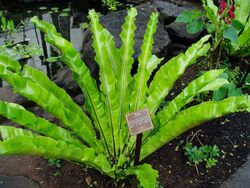Biology:Asplenium antiquum
| Asplenium antiquum | |
|---|---|

| |
| Scientific classification | |
| Kingdom: | Plantae |
| Clade: | Tracheophytes |
| Division: | Polypodiophyta |
| Class: | Polypodiopsida |
| Order: | Polypodiales |
| Suborder: | Aspleniineae |
| Family: | Aspleniaceae |
| Genus: | Asplenium |
| Species: | A. antiquum
|
| Binomial name | |
| Asplenium antiquum Makino
| |
Asplenium antiquum is a fern of the family Aspleniaceae, commonly known as bird's-nest ferns (also called spleenworts). In Japanese, it is known by ō-tani-watari and tani-watari.[1] It grows on cliffs, logs and rocks, near waterfalls, in damp forests, and on tree trunks in China , Japan , Korea, and Taiwan.[2] It is classified as an endangered species in both South Korea and Japan.[2]
Description
Asplenium antiquum is an evergreen fern, 2–3 ft. (60–90 cm).[3] It has bright green, arching blades with a pointed end and a strong midrib.[3] Asplenium antiquum can readily be distinguished from the closely related Asplenium nidus by its fronds of uniform width.
Chemical composition
Mearnsetin 3,7-dirhamnoside, a glycoside of the flavonol mearnsetin, can be found in A. antiquum.[4]
Taxonomy
A global phylogeny of Asplenium published in 2020 divided the genus into eleven clades,[5] which were given informal names pending further taxonomic study. A. antiquum belongs to the "Neottopteris clade",[6] members of which generally have somewhat leathery leaf tissue. While the subclades of this group are poorly resolved, several of them share a characteristic "bird's-nest fern" morphology with entire leaves and fused veins near the margin. A. antiquum belongs to one of these subclades, together with A. antrophyoides, A. cymbifolium, A. humbertii, and A. phyllitidis.[7] Other bird's-nest ferns, such as A. nidus sensu lato and A. australasicum, form a separate subclade which is not particularly closely related.[6]
Distribution
A. antiquum is native to temperate and subtropical East Asia, being found in southern, eastern and northeastern China , Japan , South Korea, and Taiwan, where it grows on rock faces, cliffside outcroppings, and tree branches and trunks.[1][3] It is classed as an IUCN endangered species in its native habitat in Japan and South Korea.[1]
Cultivation
Despite its endangered status in Japan and South Korea, Asplenium antiquum is a fairly common ornamental plant within the nursery trade, widely sold throughout Asia, Australia, Europe, and North and South America. This species may be grown outdoors all year-round in certain temperate and subtropical climates (for example, in sheltered, ventilated areas within USDA hardiness zones 9 and 10); elsewhere, it may live outside from approximately May through October (in the northern hemisphere; about October to March in the southern). However, it must be protected or brought-inside as a house plant when frost is a risk, or when nighttime temperatures drop below 40° F (4.44° C). It requires fairly consistent, high humidity—albeit without being so saturated as to induce rot. The ideal substrate should be aerated and well-draining, such as sphagnum moss, while still feeling like a damp, wrung-out sponge. Keep out of direct sunlight while still providing bright, indirect light. A. antiquum does best in a well ventilated but comfortable greenhouse or terrarium setup, if grown indoors, and thrives in semi-hydroponics.[3]
Some commonly available cultivars and forms in the plant trade include:
- Asplenium antiquum ‘Crissie’[8]
- ‘Hurricane’
- ‘Leslie’[9]
- ‘Osaka’
- ‘Victoria’[10]
References
- ↑ 1.0 1.1 1.2 {{citation | mode = cs1 | title = Asplenium antiquum | work = Germplasm Resources Information Network (GRIN) | url = | publisher = [[Organization:Agricultural Research ServAgricultural Research Service (ARS), United States Department of Agriculture (USDA) | access-date = 21 January 2018 }}
- ↑ 2.0 2.1 See (kowiki): Asplenium antiquum
- ↑ 3.0 3.1 3.2 3.3 Olsen, Sue. Encyclopedia of Garden Ferns. 2007.
- ↑ Mearnsetin 3,7-dirhamnoside from Asplenium antiquum. Mizuo Mizuno, Yosuke Kyotani, Munekazu Iinuma, Toshiyuki Tanaka, Hiroyuki Kojima and Kunio Iwatsuki, Phytochemistry, Volume 30, Issue 8, 1991, pages 2817-2818, doi:10.1016/0031-9422(91)85158-V
- ↑ Xu et al. 2020, p. 27.
- ↑ 6.0 6.1 Xu et al. 2020, p. 31.
- ↑ Xu et al. 2020, p. 41.
- ↑ "Asplenium antiquum ‘Crissie’ Excelsa Gardena". https://www.excelsagardens.com/?p=2854. "The leaves of this bird’s nest fern look like an elk horn. This unique fern works well in a container or in the ground."
- ↑ "Asplenium antiquum ‘Leslie’". 23 January 2024. https://leafandclay.co/products/bird-s-nest-leslie-fern. "Native to the tropical regions of Asia and east Africa, Asplenium antiquum 'Leslie' comes from the same family of ferns as the 'Nidus'. Like the Nidus, this tropical plant prefers "rainforest" conditions in partial shade or indirect sunlight, and humidity. Its leaves are differentiated from the 'Nidus' by its compact uniform width and split curly ends."
- ↑ "Arium Botanicals Asplenium antiquum’Victoria’". https://ariumbotanicals.com/products/asplenium-nidus. "Care: This fern is fairly easy going! We recommend watering as the soil starts to go dry to keep these slightly on the moist side! Avoid watering directly in the center of the plant as standing foliage in the center can lead to rot. They will do best in a bright filtered light that is shaded from any harsh direct sun!"
Sources
- Xu, Ke-Wang; Zhang, Liang; Rothfels, Carl J.; Smith, Alan R.; Viane, Ronald; Lorence, David; Wood, Kenneth R.; Cheng, Cheng-Wei et al. (2020). "A global plastid phylogeny of the fern genus Asplenium (Aspleniaceae)". Cladistics 36 (1): 22–71. doi:10.1111/cla.12384. PMID 34618950. https://onlinelibrary.wiley.com/doi/abs/10.1111/cla.12384.
External links
Wikidata ☰ Q4808118 entry
 |

